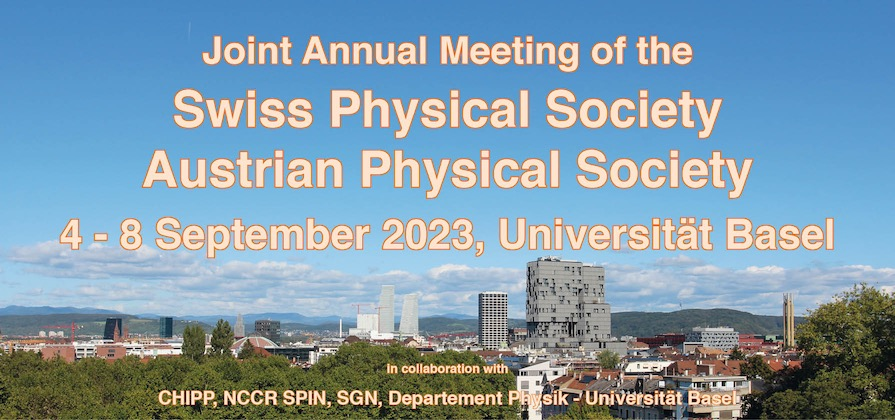Chasing new states of quantum matter is a central element in condensed matter physics, motivated both by curiosity but also by the need for understanding of many-body quantum effects. One particularly interesting system is the frustrated Shastry-Sutherland model consisting of orthogonal spin pairs. The network of Cu$^{2+}$ ions in SrCu$_2$(BO$_3$)$_2$ is topologically equivalent to this...
Intriguing topological magnetic textures, such as skyrmion lattices (SkL), have significant potential for applications to spintronic and memory devices. This potential crucially relies on finding new materials and mechanisms for SkL stabilization. So far, theory has been driving investigations of centrosymmetric SkL’s, with only a few bulk material examples, namely Gd$_2$PdSi$_3$,...
Materials with geometrical frustration are interesting study cases as they often exhibit unconventional phases of matter. While most research on frustrated materials have been performed on insulating spin systems, only little work has been done on metallic systems.
Here, I will present recent neutron scattering results of the frustrated metal HoInCu4, which features partial magnetic order...
Here we present our most recent results on the effects of charge disorder on classical spin ice. Motivated by our obsrvations in the effects of correlated disorder in both structure and magnetism of fluoride pyrochlore compound CsNiCrF$_{6}$ we set out to study the effects of charge disorder in B-site of classical spin ice, Ho$_{2}$Ti$_{2}$O$_{7}$, our system of choice is Ho$_{2}$ScTaO$_{7}$....
Patterns of nano-scale magnets are important systems to investigate potential applications but also fundamental physics of dipole-diple interactions. With certain frustration, artificial spin-ices can be created with highly degenerate ground states. These form only short range magnetic correlations that were predicted by Monte-Carlo simulations.
We have used GISANS to study the magnetic...
We report high-resolution neutron diffraction on the heavy fermion antiferromagnet Ce3TiSb5. Our specific heat and magnetic susceptibility measurements as a function of magnetic field reveal a phase diagram with three distinct magnetic phases. Using neutron diffraction we study the magnetic structure, and uncover a multi-k spin structure in the intermediate field phase. Magnetic multi-k...
Quantum simulators are experimentally available materials, which satisfy well-defined quantum Hamiltonians and allow the quantitative prediction of spectacular many-body effects. An example of such materials are ideal spin ladders. So far, only one strong-leg spin ladder was studied. We recently managed, thanks to a breakthrough, to grow a second strong-leg spin ladder in large crystals, and...
Despite the undoubted success of the Standard Model of particle physics, it fails to answer many longstanding questions. These include the observed dark matter and the baryon asymmetry in our universe. Many theoretical models that try to answer those questions require new particles and gauge bosons, which must be verified or excluded experimentally.
In this talk, I will present the search for...
The interplay among electronic charge, orbital, spin and lattice degrees of freedom in quantum materials can stabilize a variety of collective phenomena. Substantial understanding concerning the microscopic origin of these correlated quantum phases is gained through microscopic studies susceptible to the various degrees of freedom, and their dependencies on external tuning parameters. Here, we...
Neutron scattering experiments under high pulsed magnetic fields offer valuable insights into magnetic structures of materials. However, these experiments are challenging and time-consuming due to low neutron count. To address this, we proposed the idea of a specialized source, designed to increase neutron count and improve brilliance serving only one single instrument. The main features of...
High-precision measurements of angular correlations in neutron beta decay address a number of questions which are at the forefront of particle physics. For a new generation of beta decay experiments, like the PERC currently under construction in Munich, frequency-based beta spectroscopy using the cyclotron radiation emitted by electrons in a homogeneous magnetic field have been emerging. PERC...
Zirconium alloys are used as nuclear fuel cladding material, but hydrogen is taken up by the cladding during operation and precipitates during cooling. During interim dry storage the cladding tubes are affected by mechanically and thermally induced stresses. In order to investigate zirconium and cladding tubes at similar conditions, we observe in-situ the hydrogen diffusion in dependence of...
Grain-oriented silicon steels are established as high performance magnetic core materials in transformers. Their large crystal grains with strong texture gives them pronounced uniaxial magnetic properties. Polarized neutron imaging is capable of investigating the bulk magnetic properties with spatial resolution. The technique is capable sensitive to magnentic order and disorder in the form of...
The reaction of hot nuclear fuel rods with steam results in production of free hydrogen. The released part of this hydrogen provide the risk of hydrogen detonation The other part is absorbed in the fuel cladding tubes made of zirconium alloys. This is the more dangerous one because it can be result in an embrittlement of the cladding tubes and with it in a destruction of the tubes by...
Hybrid implants consisting of a permanent Ti-based part combined with a degradable Mg part, are promising solutions to improve the biocompatibility and stability of current implants. In these implants the Ti provides high strength while temporary Mg part is used for bone stimulation or drug delivery. As Mg degrades hydrogen gas is released which ingresses into the Ti part, leading to changes...
